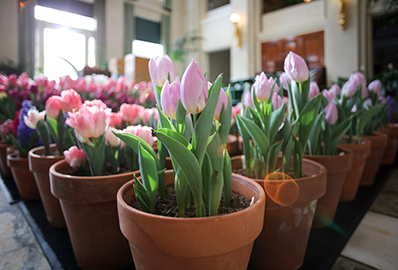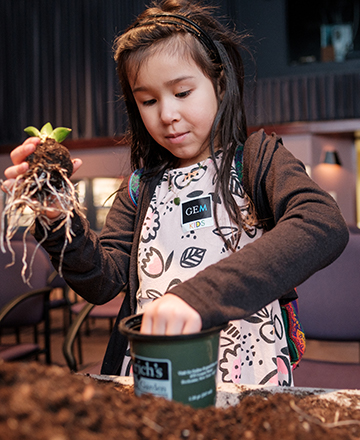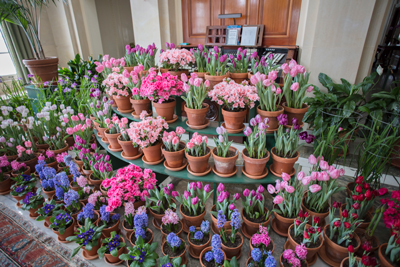The Eastman Museum’s annual “Dutch Connection” show shares in the struggle against winter blues
Story by John Ernst; photos provided by the George Eastman Museum

In 1895, 41-year-old George Eastman bicycled through Holland. “Two large fields that we passed were the greatest blaze of color I ever saw,” he wrote home to his mother in Rochester. “Reds, yellows, pinks, and white flowers three inches in diameter and the blossoms covered the ground. If we can grow them I will have a bed next year.” And he did just that. After his botanical bewilderment overseas, Eastman ordered tens of thousands of bulbs from Holland each year until his death. According to Eastman House landscape manager Dan Bellavia, “One of the reasons he built greenhouses is so he could have flowers in the house at all times.” Each year, Eastman’s live-in servants would transform his home into a Dutch summer field. After he built his East Avenue mansion in 1905, this meant constructing five greenhouses to prepare fifty rooms’ worth of floral color. Later, in 1917, he even dug a tunnel from a greenhouse to his house to prevent the winter cold from hurting plants when it was time to transfer them.
One hundred years after that loving letter to his mother, the Eastman Museum decided to bring the billionaire-philanthropist’s tradition to the people of Rochester. The event has continued to grow each year, and its twenty fifth anniversary is no exception. “It’s become almost a year-round job for me and my crew,” Bellavia says. “I have my orders in by June and they’re usually delivered in the last week of September.” After months of expert care in their greenhouses, the flowers are brought into the house for the Dutch Connection in February. “We almost always have extras that live longer than we expect, so it ends up going until the second or third week of March.” April through June involves cleaning and disinfecting fifteen thousand pots before it’s time to order again.
Bellavia only has two employees, so the event runs on volunteers and community engagement. “We’d be nowhere without them. We try and feed them breakfast and coffee, but we can’t thank them enough,” he continues. “We have anywhere from 12,000 to 15,000 flowers that need to be watered every two days.” From the beginning, the primary economic force behind the Dutch Connection has been local sponsors Gerald P. and Karen S. Kral. “The museum was just starting up in ’95, so we knew they were interested in helping with gardens and initially asked if they could help with just the printing costs,” Bellavia says. “Since then, they’ve donated and sponsored the show ever since. And each year they seem to find a way to help out more.” Each year the museum spends roughly $12,000 on the event—up to $8,000 on bulbs alone.

Two years ago, Bellavia and his team developed a program for kids to plant their own bulbs and learn about gardening and community stewardship. “I really push education,” he says. “They learn a little bit about gardening, and they take it home to watch it grow and bloom. Then they can plant them in their gardens outside.” This year the openings have almost doubled from 2017’s slots. Bellavia notes that a lot of parents grow tired of “big germ factories” like some children’s museums in winter, so the Dutch Connection is a great opportunity to try something new. “But anything to get your kid’s nose out of their phone is great,” he laughs.
After the success of the kids’ event’s first year, the Eastman House decided to try something special for adults. “Learning to plant bulbs is just as enriching for grown-ups as it is for kids,” Bellavia says, “but we wanted to couple it with something trendy.” After partnering with Bushnell Basin’s Lost Borough Brewing Co, “Blooms and Brews” was born. “We allowed 60 people to come in, plant some bulbs, and try samples of Lost Borough’s new seasonal beers,” he says. Admission to Blooms and Brews includes a house tour and a series of appetizer pairings for each beer.


The Eastman House utilized Cornell University’s extensive archive of Eastman’s catalogs to determine his exact orders. “I still deal with one company he originally ordered from,” Bellavia says. “some of the varieties of tulips are no longer in existence, but we order the closest varieties we can.” Eastman ordered nine types of tulips, differing namely in the time that they bloom. That way, Bellavia says, he’d have flowers blooming far beyond the typical season— “especially when he’d plant them outside, he’d have tulips blooming for two months.” Eastman’s catalogs also show narcissi (daffodils and paperwhites), hyacinths, amaryllis, freesia, clivias, hellebores, English and German primulas, Rieger begonias, and azaleas. “Depending on availability, I like to add another annual or two,” Bellavia says, “but I don’t know what until just before the show.” Interestingly, George Eastman favored monochromatic displays— “so it would be all pink or all white.”
When you cut through the glamor and class, there’s a simple reason Eastman chose to decorate his home with flowers—to uplift spirits through the winter. “February, you know, is lovely around here,” Bellavia laughs. “But by getting people in here, we remind them that winter’s almost over. And there’s a light at the end of the tunnel.” As depression-fighting as the flowers themselves can be, watching them grow and develop adds a new level to the good-mood magic. “If you come in one day it’ll look gorgeous,” he continues. “But if you come a few days later, you’ll see the changes as bulbs open up and the flowers change color. You see the differences.” Bellavia notes that a membership to the museum makes it easy to return as often as you’d like.
“After working here fifteen years,” he says, “I still walk in some mornings and just go, ‘wow.’”
John Ernst is a writer and graphic designer based in Rochester. See more of his work at johnmwrites.com.
Views: 0






